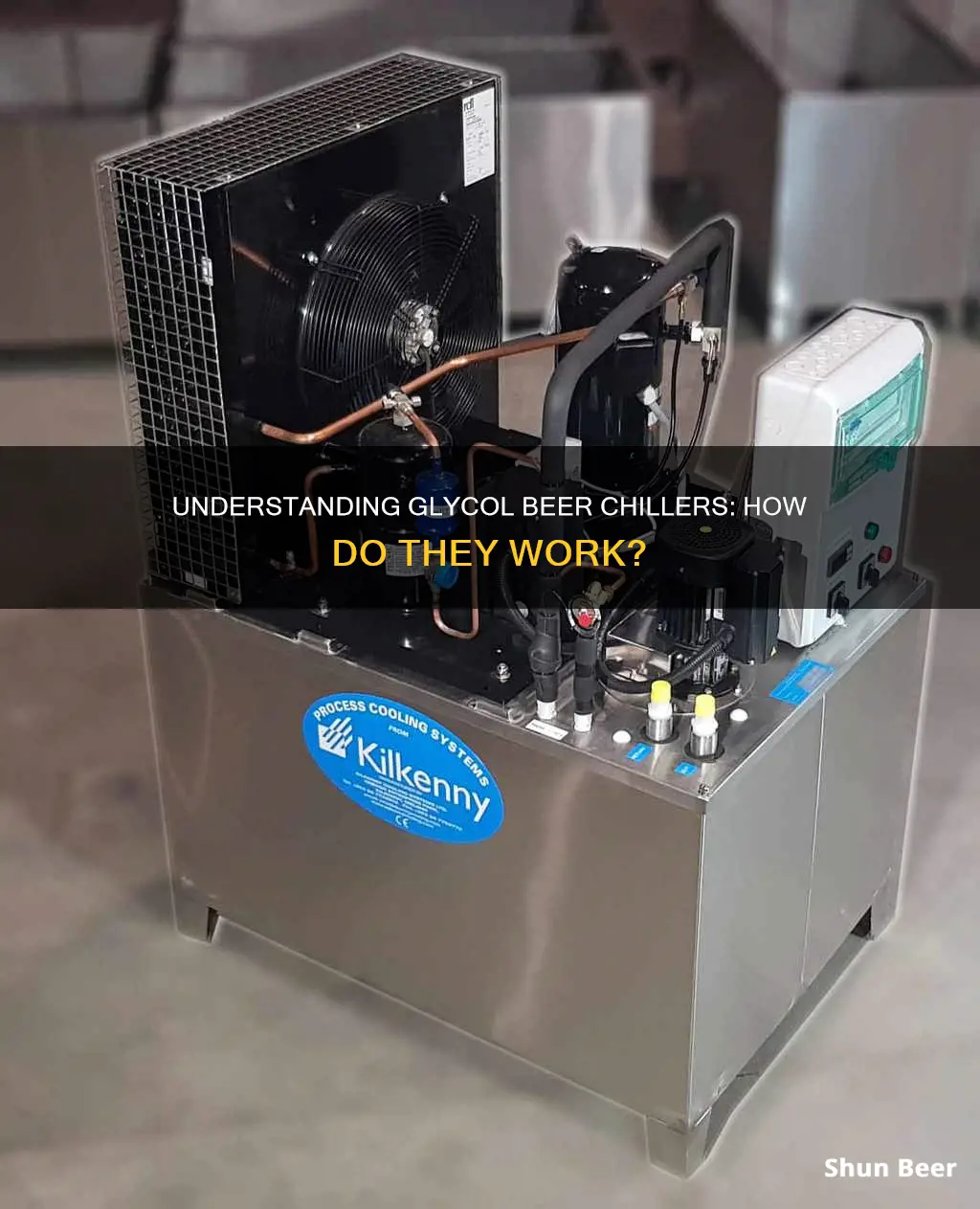
Glycol chillers are specialised refrigeration systems that are often used to cool liquids, including alcohol and other beverages. They are commonly used in bars, pubs, and restaurants to serve cold draft beer. A glycol chiller is a compact refrigeration unit that cools down beer and maintains the required temperature as the beer travels through a beer line from a walk-in cooler to the draft beer tower. The glycol never comes into contact with the beer. Instead, it is pumped through the glycol line, which is placed together with the beer line inside a trunk line. This setup ensures that the beer never gets warm and arrives foam-free at the dispensing point.
| Characteristics | Values |
|---|---|
| Purpose | To cool beer and maintain the required temperature as it travels through a beer line from a walk-in cooler to the draft beer tower |
| Main component | Propylene glycol |
| Other components | Compressor, evaporator, condenser, metering device, buffer tank |
| Use | In long-draw draft beer systems, especially when the chiller is at least 75 feet away from the dispensing point |
| Benefits | Allows delivery of beer over long distances (up to 450 feet), serves a larger number of beer towers, minimises pour cost, improves chiller efficiency, extends service life, reduces vibration and noise levels |
| Ideal propylene glycol to water ratio | 35%–40% |
| Temperature range | 25–27°F |
| Glycol freezing point | -59°C (-74.2°F) |
| Glycol line placement | Placed together with the beer line inside a trunkline |
| Glyco chiller placement | As close to the tanks as possible |
| Pipe types | Copper, nylon-braided rubber hose, pre-insulated schedule 80 PVC, ABS plastic, cross-linked polyethylene (PEX) |
What You'll Learn

Glycol chillers are specialised refrigeration systems
A glycol chiller is a compact refrigeration unit that cools beer and maintains the required temperature as the beer travels through a beer line from a walk-in cooler to the draft beer tower. The glycol chiller acts as a refrigeration unit within a typical draft beer system. Inside the glycol chiller is a reservoir of glycol that is pumped through the glycol line (or lines) placed together with the beer line inside a trunk line. The beer lines come into contact with the cold glycol lines, ensuring the beer remains cold and arrives foam-free at the point of dispense.
The glycol used in chillers is propylene glycol, a food-grade antifreeze that is non-toxic. It is important to distinguish this from ethylene glycol, which is used in vehicles and is extremely toxic. Propylene glycol has a freezing point of -59°C (-74.2°F), which can be altered by mixing it with water. The ideal propylene glycol to water ratio is typically 35%–40%.
Glycol chillers are particularly useful for long-draw draft beer systems, where the chiller is located at least 75 feet away from the dispense point. They allow beer to be delivered over long distances, serve a larger number of beer towers, and minimise pour costs.
Understanding Beer Shanks: How Do They Work?
You may want to see also

Propylene glycol is a food-grade antifreeze
One of the main advantages of using propylene glycol in beer cooling systems is its non-toxicity. Unlike ethylene glycol, which is used in automotive antifreeze, propylene glycol is safe for human consumption. This makes it ideal for applications where the product comes into direct contact with the consumable, such as in beer lines and dispensing systems.
Propylene glycol has a very low freezing point of -59°C (-74.2°F), which makes it an excellent cooling agent. By mixing it with water, the freezing point can be adjusted to suit different applications. For most beer cooling systems, a mixture of 35% to 40% propylene glycol and 65% to 60% water is ideal. This mixture provides a freezing point range of 26°F to -8°F, which is suitable for maintaining the desired serving temperature of beer.
When using propylene glycol in a beer cooling system, it is important to ensure that it is of USP (United States Pharmacopeia) grade and inhibited to prevent corrosion. This ensures that the glycol is of the highest quality and safe for use in food and beverage applications. Regular maintenance and proper handling of the glycol solution are also important to maintain system efficiency and prevent contamination.
Propylene glycol is a versatile and widely used ingredient that offers benefits such as improved product stability, extended shelf life, and enhanced texture and consistency. In addition to its use in food and pharmaceutical applications, propylene glycol is also commonly used in cosmetics, humidors, and even automotive antifreeze, where its non-toxicity makes it a safer alternative to ethylene glycol.
Beer Sleeves: Do They Keep Drinks Cool?
You may want to see also

The right glycol/water ratio is important
Glycol chillers are specialised refrigeration systems that are often used to cool liquids, including beverages like beer. They are a popular application in beverage production, where food-grade chemical propylene glycol is used. Propylene glycol is an important component of a long-draw draft beer system, helping to cool the beer and maintain the right temperature as it is dispensed.
The ideal propylene glycol to water ratio for most applications is typically between 35% and 40%. This ratio ensures that the mixture remains stable and does not freeze at temperatures relevant for beverage cooling. A 35% glycol mix is particularly effective, providing a steady freezing point suitable for cold environments. It is important to refer to the manufacturer's indicated burst point, which is the temperature at which the equipment becomes vulnerable to failure, to ensure the glycol/water ratio is appropriate.
Maintaining the proper glycol/water ratio is crucial to prevent issues such as freezing or reduced system efficiency. Too little glycol can lead to freezing, especially if the desired temperature is low, while too much glycol can impact heat transfer and increase viscosity, reducing the system's ability to cool effectively. Therefore, it is important to carefully calculate and maintain the correct ratio to ensure optimal performance of the glycol chiller.
Beer Traps: Effective Earwig Control or Urban Myth?
You may want to see also

Glycol chillers are ideal for long-draw systems
Propylene glycol is a food-grade antifreeze that is non-toxic and safe for use in consumable products. It has a freezing point of -59°C (-74.2°F), which can be adjusted by mixing it with water. The ideal propylene glycol to water ratio is typically around 35%–40%. This mixture is pumped through a glycol line that is placed together with the beer line inside a trunk line. By keeping the beer lines in contact with the cold glycol lines, the beer stays cold and arrives foam-free at the point of dispensing.
Glycol chillers offer several benefits over other cooling methods. They allow for the delivery of beer over long distances (up to 450 feet) and can serve a larger number of beer towers with different designs. They also improve chiller efficiency, extend the service life of the equipment, and reduce vibration and noise levels. Additionally, glycol-cooled draft beer systems can eliminate foam when dispensing beer, resulting in up to 10% less beer wastage.
When choosing a glycol chiller, it is important to consider factors such as brewing frequency, time between brews, and desired tank volume. The size of the glycol chiller and the amount of glycol required will depend on these factors. Glycol chillers are also easy to install and maintain, making them a cost-effective solution for businesses looking to serve perfectly chilled beer.
Understanding Beer Screens: The Science Behind the Suds
You may want to see also

Glycol chillers improve efficiency and reduce noise
Glycol chillers are specialised refrigeration systems that are commonly used to cool liquids, including beverages such as beer. They are an effective way to maintain temperature control during the fermentation process, which is crucial in brewing beer.
The use of glycol chillers offers several advantages that contribute to improved efficiency. Firstly, they enable rapid cooling, allowing producers to lower the temperature of the beer quickly as needed. This is particularly useful in crash cooling beer after fermentation or when cooling the wort after the initial boiling process. Secondly, glycol chillers provide precise temperature control, ensuring that the beer remains at the desired temperature throughout the dispensing process. This helps prevent overheating during fermentation, giving brewers better control over the internal temperatures and, ultimately, more quality control over their beer.
The efficiency of glycol chillers is further enhanced by their ability to prevent system blockages and maintain flow velocity. By protecting the system from low temperatures, glycol chillers reduce the risk of freezing, which could lead to blockages and decreased flow velocity. This, in turn, helps maintain optimal system efficiency.
In addition to improving efficiency, glycol chillers also offer noise reduction benefits. The glycol lines are placed in close contact with the beer lines inside a trunkline, allowing for direct heat transfer without the need for mechanical pumps or excessive vibration. This results in a quieter dispensing process compared to alternative cooling methods.
The combination of efficiency and noise reduction makes glycol chillers a popular choice for beverage production, especially in the brewing industry, where temperature control is critical to the final product's quality.
Beer Science: Brewing Chemistry and History Podcast
You may want to see also
Frequently asked questions
A glycol chiller is a compact refrigeration unit designed to cool beer and maintain the required temperature as the beer travels through a beer line from a walk-in cooler to the draft beer tower.
Glycol is a non-evaporating refrigeration liquid that can achieve cold temperatures without freezing. The glycol is pumped through the glycol line (or lines) that are placed together with the beer line inside a trunk line.
You should use inhibited USP-grade propylene glycol, which is a food-grade antifreeze. This type of glycol is deemed safe by the FDA and the United States Pharmacopeia (USP).
Glycol chillers allow you to deliver beer over long distances (up to 450 feet), serve a larger number of beer towers with different designs, and minimize pour cost. They also improve chiller efficiency, extend service life, and reduce vibration and noise levels.
To set up a glycol chiller, you need to determine the desired tank volume, temperature differential, and cooldown time. You will also need to calculate the total system volume, which includes the volume of the piping, tank jackets, and chiller system reservoir.







